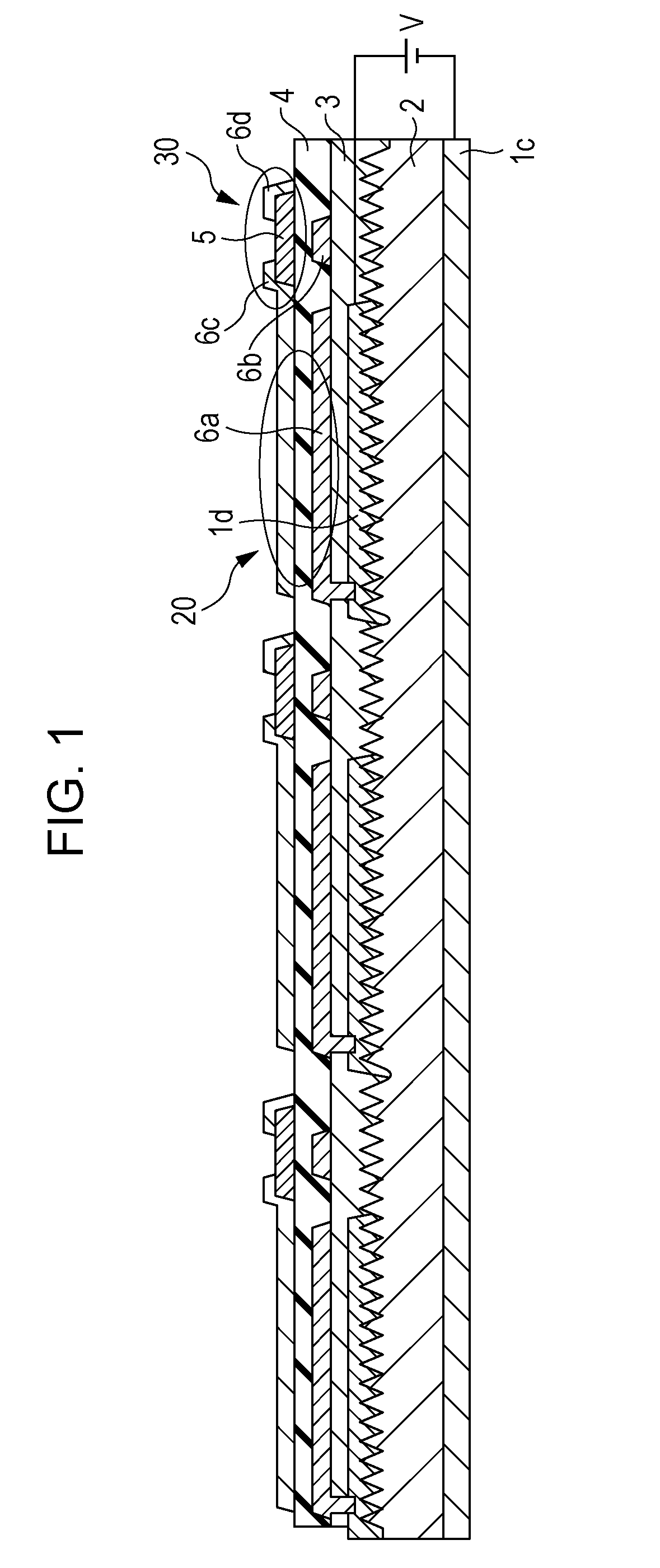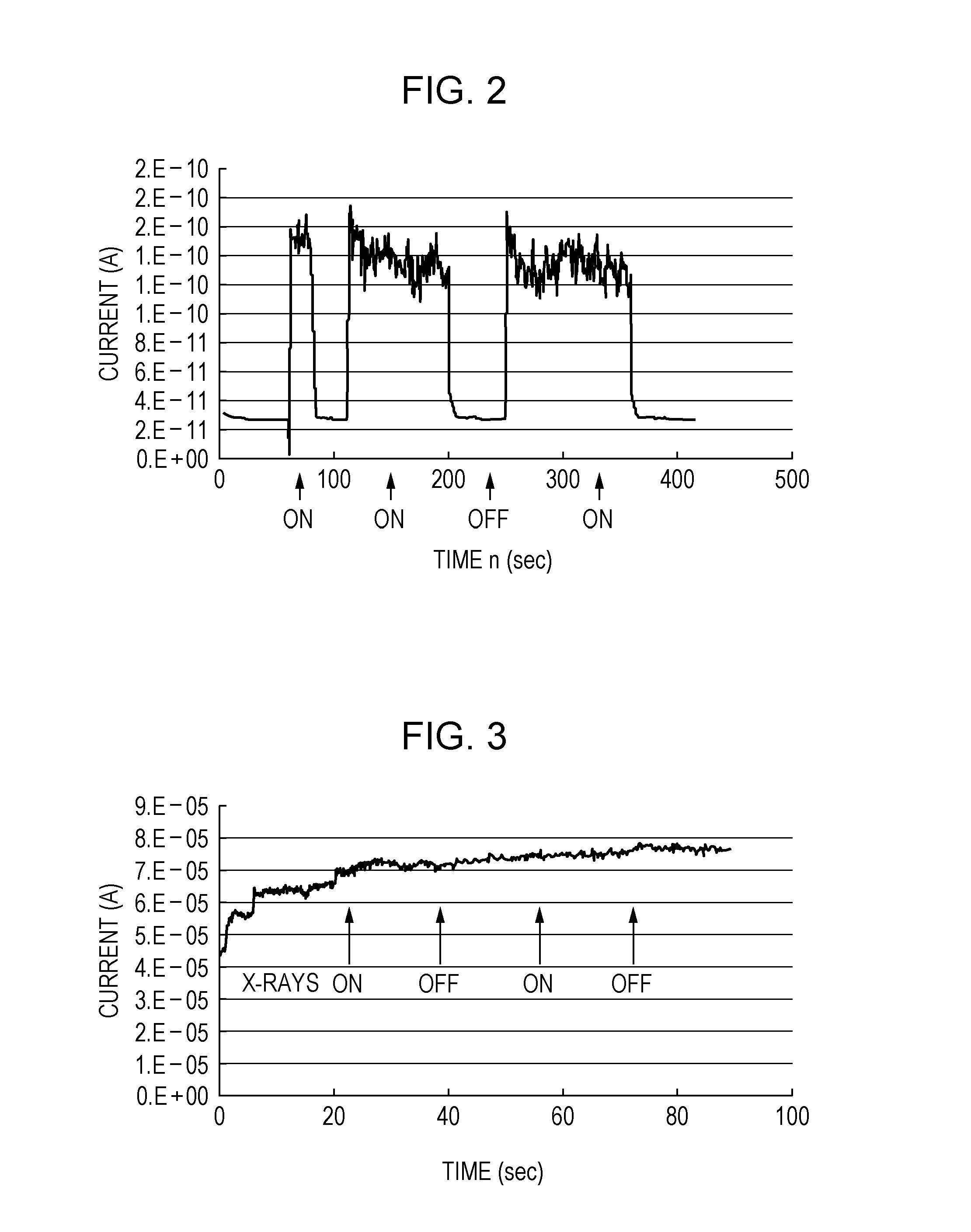X-ray detector and method for manufacturing the same
a technology of x-ray detector and manufacturing method, which is applied in the field of x-ray detector, can solve the problems of increasing manufacturing costs, deterioration and degradation of other components, and long time, and achieves the effects of reducing the manufacturing cost of x-ray detector, facilitating the formation of x-ray photoelectric conversion layer, and sufficient thickness
- Summary
- Abstract
- Description
- Claims
- Application Information
AI Technical Summary
Benefits of technology
Problems solved by technology
Method used
Image
Examples
example 1
[0034]An X-ray detector array illustrated in FIG. 1 includes an X-ray photoelectric conversion layer 2, a collecting electrode 1d, a common electrode 1c, a storage capacitor 20, and a readout unit 30. The X-ray photoelectric conversion layer 2 produces electric charges in proportion to the X-ray irradiation intensity. The collecting electrode 1d collects the electric charges produced by the X-ray photoelectric conversion layer 2. The common electrode 1c is disposed on a surface of the X-ray photoelectric conversion layer 2 opposite to the collecting electrode 1d. The storage capacitor 20 stores the electric charges collected by the collecting electrode 1d. The readout unit 30 reads out the electric charges stored in the storage capacitor 20.
[0035]A voltage V is applied between the collecting electrode 1d and the common electrode 1c. The X-ray photoelectric conversion layer 2 is formed of a polycrystalline oxide.
[0036]It is desirable that the polycrystalline oxide be mainly composed ...
example 2
[0045]A polycrystalline ceramic mainly composed of zinc oxide is used as the polycrystalline oxide. In—Ga—Zn—O, Zn—Sn—O, Cd—Sn—O, or Cd—Ge—O can also be used as the polycrystalline oxide. The polycrystalline ceramic is formed into a sheet. An electrode is printed on the sheet. The sheets are stacked and sintered.
[0046]Electrodes disposed between the sheets are alternately connected on the opposite sides of the sheets. A voltage is applied between the opposite sides. For example, an electrode on a sheet is connected to an electrode on the right side, and an electrode under the sheet is connected to an electrode on the left side. In the layered sheets, the electrodes are stacked in such a staggered form.
[0047]In an example illustrated in FIG. 4, a collecting electrode 40 is disposed on a polycrystalline oxide that forms the X-ray photoelectric conversion layer 2, and a first internal electrode 41 and a second internal electrode 42 are disposed within the polycrystalline oxide of the p...
example 3
[0052]An X-ray detector array is fabricated using a layered structure in which a plurality of polycrystalline oxide sheets and a plurality of electrodes are alternately stacked.
[0053]As illustrated in FIG. 5, a common electrode 1c and a collecting electrode 1d are formed on the opposite surfaces of a polycrystalline oxide of the X-ray photoelectric conversion layer 2 (described in Example 1 with reference to FIG. 1). An internal electrode 1b and an internal electrode 1a are formed within the polycrystalline oxide of the photoelectric conversion layer 2. The internal electrode 1b is connected to the common electrode 1c, and the internal electrode 1a is connected to the collecting electrode 1d.
[0054]As illustrated in FIG. 5, the internal electrode 1a includes three electrodes, and the internal electrode 1b also includes three electrodes. The three electrodes of the internal electrode 1a and the three electrodes of the internal electrode 1b are alternately disposed. The left ends of t...
PUM
 Login to View More
Login to View More Abstract
Description
Claims
Application Information
 Login to View More
Login to View More - R&D
- Intellectual Property
- Life Sciences
- Materials
- Tech Scout
- Unparalleled Data Quality
- Higher Quality Content
- 60% Fewer Hallucinations
Browse by: Latest US Patents, China's latest patents, Technical Efficacy Thesaurus, Application Domain, Technology Topic, Popular Technical Reports.
© 2025 PatSnap. All rights reserved.Legal|Privacy policy|Modern Slavery Act Transparency Statement|Sitemap|About US| Contact US: help@patsnap.com



